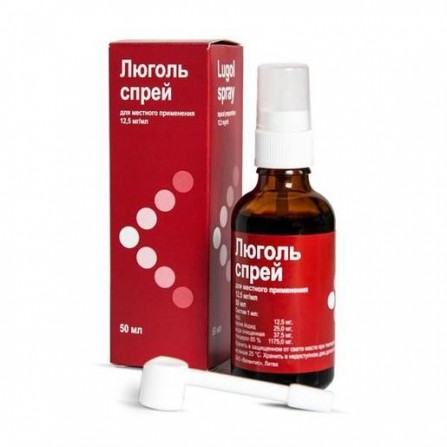More info
Description
Lugol - the main active ingredient is molecular iodine, which has an antiseptic and irritant effect. It has a bactericidal effect against gram-negative and gram-positive flora, and also acts on pathogenic fungi (including yeast); Staphylococcus spp. more resistant to iodine, but with prolonged use of the drug in 80% of cases there is a suppression of the staphylococcal flora; Pseudomonas aeruginosa is resistant to the drug. When applied to extensive surfaces of the skin and mucous membranes, iodine has a resorptive effect: it participates in the synthesis of TK and T4. The potassium iodide improves the dissolution of iodine in water, and glycerol has a softening effect.
Active ingredients
Iodine + [Potassium Iodide + Glycerol]
Release form
Spray
Pharmacological effect
The main active ingredient is molecular iodine, providing an antiseptic and local irritating effect. It has a bactericidal effect against gram-negative and gram-positive flora, and also acts on pathogenic fungi (including yeast), Staphylococcus spp. more resistant to iodine, but with prolonged use of the drug in 80% of cases there is a suppression of the staphylococcal flora, Pseudomonas aeruginosa is resistant to the drug. When applied to extensive surfaces of the skin and mucous membranes, iodine has a resorptive effect: it participates in the synthesis of TK and T4. The iodide in potassium improves iodine dissolution in water, and glycerol has a softening effect.
Pharmacokinetics
In the case of the use of the drug in the recommended doses, resorption of iodine through the skin and mucous membranes of the oral cavity is insignificant. When in contact with mucous membranes by 30% turns into iodides. If swallowed accidentally, iodine is rapidly absorbed. The adsorbed part penetrates well into tissues and organs, accumulates in the tissues of the thyroid gland. Excreted by the kidneys (mainly), to a lesser extent with feces and with sweat. Penetrates the milk of lactating women.
Indications
Infectious and inflammatory diseases of the mucous membranes of the oral cavity and pharynx in adults and children.
Contraindications
Hypersensitivity to iodine preparations.
Use during pregnancy and lactation
The use of the drug during pregnancy is not recommended.Use during breastfeeding is possible if the expected benefit to the mother outweighs the potential risk to the baby. Need to consult a doctor.
Dosage and administration
The drug is applied topically by one pressing 4 - 6 times per day for irrigation of the mucous membrane of the oral cavity, pharynx, and pharynx. At the time of injection is recommended to hold your breath.
Side effects
Possible development of iodism phenomena: runny nose, skin rash as urticaria, salivation, tearing, contact dermatitis, erythema, dry skin, slight burning, itching, bronchospasm, nausea, vomiting, angioedema (in some patients because of the smell of the drug), redness on the place of application.
Overdose
Symptoms: irritate the upper respiratory tract (burn, laryngobronchospasm), if ingested - the mucous membranes of the gastrointestinal tract, the development of hemolysis, hemoglobinuria, lethal dose - about 3 g (about 300 ml of the drug). , solution of sodium bicarbonate, sodium thiosulfate 30% is introduced in / to 300 ml.
Interaction with other drugs
Iodine is inactivated by sodium thiosulfate. The iodine contained in the preparation oxidizes the metals, which can lead to damage to metal objects. Pharmaceutically incompatible with essential oils, ammonia solutions. Alkaline or acidic environment, the presence of fat, pus, blood weaken antiseptic activity.



